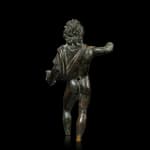Hellenistic
Further images
Provenance
Schlomo Moussaieff (1925 - 2015) Collection, Israel and London, formed between 1948 - 2000
Gorny and Mosch, Munich, 13 December 2017, lot 267
Private collection, acquired from the above
Literature
The figure appears close to the Alexander Doryphoros type of Alexander holding his spear, usually with a short sword (parazonium) in his other. These smaller bronzes are copies of, or inspired by an original attributed to Lysippos, the court sculptor to Alexander the Great. They assert an image of a king whose authority over his ‘spear-won’ land is a gift from the gods. This example is a highly muscular rendering, and a variant on the traditional Doryphoros as although he likely originally held a spear, there are drilled holes in the raised right arm for insertion of a separate, now lost, attribute.
According to Andrew Stewart, such statues ‘simultaneously flaunted the source of his power (his physical and martial prowess) and served as icons of his personal dominion over Asia [….]. By successfully manipulating Greek society’s central symbolic form, these portraits transformed the nude, youthful, heroic victor of surpassing arete into the charismatic young king of Asia’: A. Stewart, Faces of Power, Alexander’s Image and Hellenistic Politics, Berkeley, 1993, p. 167.
The image of Alexander through his program of portrait sculpture conveys a multitude of messages but the Alexander Doryphoros encapsulates his assertion of martial arete, his god-given personal power and victory; it is a potent symbol of a conqueror, of his dominion, in an unequivocal visual language entirely understood by the ancient Greek viewer. For further discussion see A. Stewart, Faces of Power, Alexander’s Image and Hellenistic Politics, Berkeley, 1993; M. Bieber, Alexander the Great in Greek and Roman Art, Chicago, 1964.





